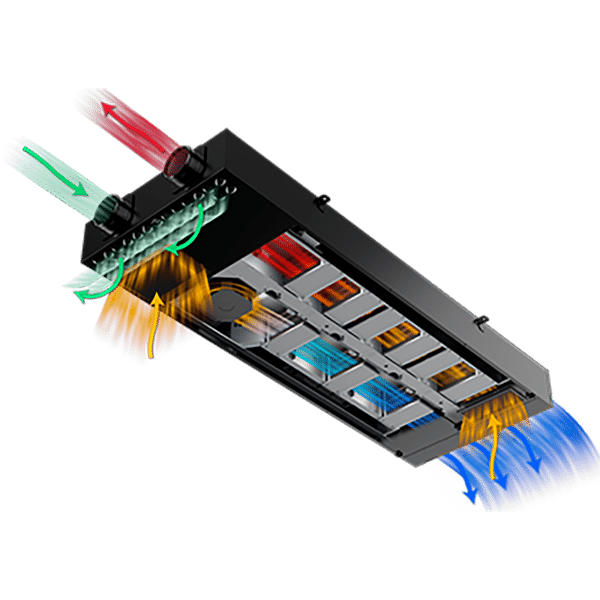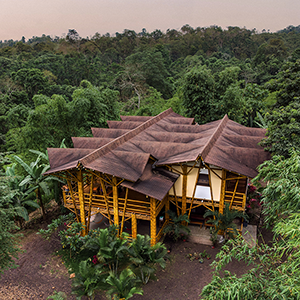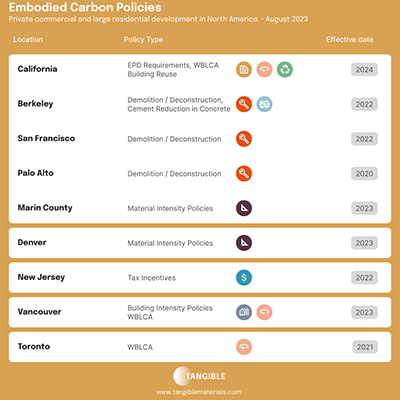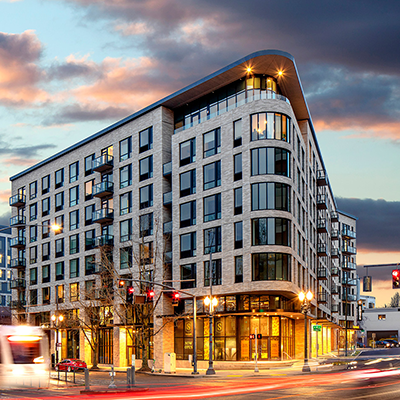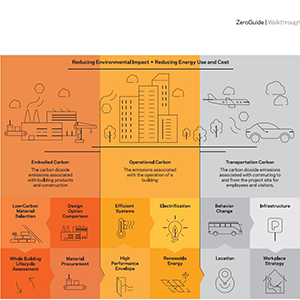Magnusson Klemencic Associates (MKA):
A Focus on Making a Climate Difference
Finding creative and innovative structural engineering solutions has proved to be one of the most rewarding aspects of our careers. But perhaps the biggest challenge of our generation remains unresolved—reducing the Architecture, Engineering, and Construction (AEC) industry’s collective impact on the environment.
While floorspace in buildings is estimated to double in the next 40 years, today our industry is responsible for nearly 40 percent of global greenhouse gas emissions. It is essential that engineers, property owners, designers, and contractors find business strategies that reduce carbon emissions and limit climate change.

The Amazon Spheres in downtown Seattle. Photo credit: Bruce Damonte, courtesy MKA
At Magnusson Klemencic Associates (MKA), we view this challenge as a tremendous opportunity for the AEC industry to make a meaningful difference, and we have invested resources toward that goal in two important ways.
- Focusing on Water and Carbon — As civil and structural engineers, we recognized 10 years ago that we could most meaningfully reduce our environmental impact by focusing on water use and embodied carbon. For Water, MKA’s Civil Group initiated a Green Roof net-zero water research study, developed a Sustainable Water Analysis Tool, and co-authored the Onsite Non-Potable Water Reuse Practice Guide. For Carbon, we helped start the Carbon Leadership Forum (CLF) and Building Transparency, two non-profit organizations committed to addressing embodied carbon’s harmful impact on the environment. Similarly, we have helped with the Architecture 2030 Products Challenge and the SE 2050 Challenge, two initiatives that aim to reduce harmful emissions and embodied carbon in the built environment. MKA is advancing new material uses of mass timber and bamboo in prefabricated and composite structures, and we have pioneered ideas around low-carbon concrete and performance-oriented concrete specifications. Recently, MKA published the Low-Carbon Concrete Implementation Strategy, which can be found on CLF’s website.
- MKA Foundation — A non-profit committed to supporting innovative design advancements within the built environment, the MKA Foundation is keenly interested in championing long-term, eco-friendly tools and solutions. These include both financial and in-kind investments for non-proprietary initiatives, such as the Embodied Carbon in Construction Calculator (EC3), which transparently measures, compares, and reports embodied carbon emissions in construction materials; the OpenIMPACT Life Cycle Analysis (LCA) open-source data initiative; and sponsorship of Climate-Smart Forestry’s Leadership Summit for Climate, Wood & Forests. The MKA Foundation is engaged with next-generation materials testing that involves composite concrete and laminated bamboo fibers, and with the creation and publication of design-practice guides for Onsite Non-Potable Water Reuse; Low-Carbon Concrete; Performance-Based Seismic, Wind and Fire Engineering; and more.
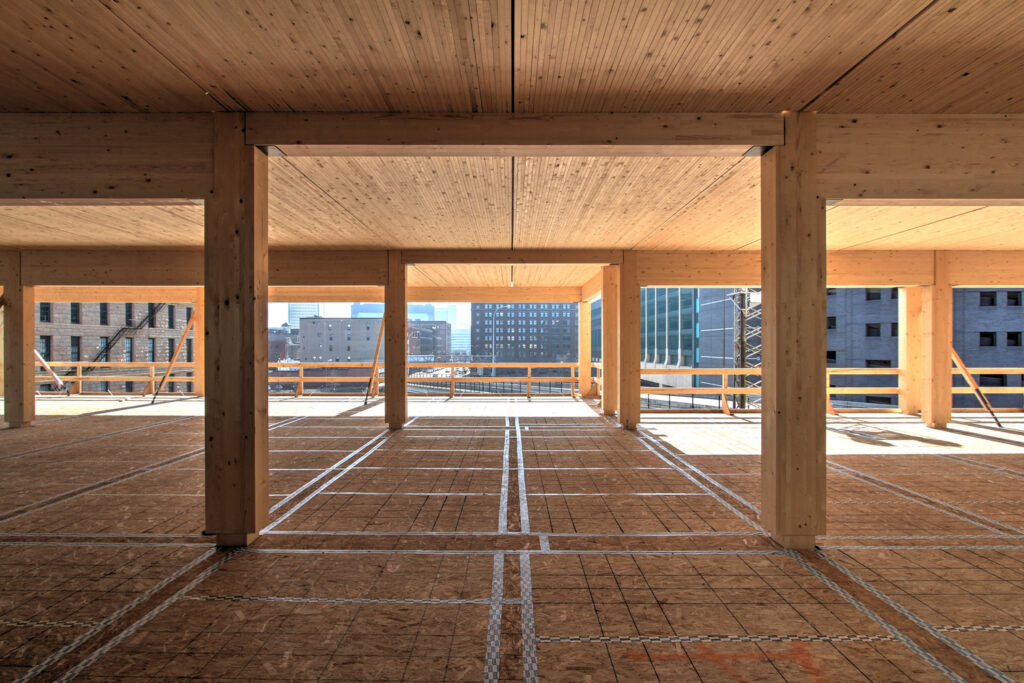
T3 Minneapolis, one of the first, commercially successful, high-rise, mass-timber office buildings of this scale in America. Photo credit: Michael Dickter, Courtesy MKA
Putting Ideas into Practice
At MKA, we constantly explore and advance new approaches to the engineering challenges within every project, looking to incorporate and enable environmentally mindful features within these designs.
For example, T3 Minneapolis—at seven stories and nearly 270,000 square feet—was one of the first, commercially successful, high-rise, mass-timber office buildings of this scale in America. That successful project with Hines Development has led to many other T3 projects across the country.
In downtown Seattle, three intersecting, glass-and-steel Spheres at Amazon’s urban corporate headquarters are not only inspiring for environmentally conscious ideation, but the glass-and-steel orbs, “treehouse” meetings rooms, waterfalls, and four-story “living wall” were designed using biomimicry-inspired material and shape optimization design philosophies. The result is a beautiful structure with high system repetition; a reduced waste stream within the fabrication process; and form, function, and efficiency on display throughout the exposed building frame.
True, these innovative and creative projects inspire and encourage us to pursue climate-conscious design solutions. But more than any single building, the macro “project” of changing how we design buildings to use Earth’s limited and precious resources more optimally and responsibly is where we are most inspired, and where we look to find partners who choose to do the same.

For Water, MKA’s Civil Group initiated a Green Roof net-zero water research study, developed a Sustainable Water Analysis Tool, and co-authored the Onsite Non-Potable Water Reuse Practice Guide.
A project renovation or re-use should always be considered first. However, if new construction is necessary, it is essential to use lower-carbon structural materials and optimize those materials at every step of the design process. This includes paying attention to how these materials are made and from where they come, as the latter can often have a greater carbon impact on a new building’s carbon footprint than the choice of material itself—be it wood, steel, or concrete. The idea that “you can’t manage what you don’t measure” has been a driving force behind many MKA efforts to focus on tracking and optimizing material quantities, and then measuring and reporting the carbon footprints of these materials. That latter reporting creates a more informed decision-making process that rewards lower-carbon material suppliers within the supply chain. This encouragement leads to more innovation around lower-carbon solutions. When focus is placed on these simple ideas, we create win-win scenarios for our clients, the industry, and the environment.
In summary, by advancing carbon-accounting methods in construction, nurturing innovations, and designing structures that all move toward reduced carbon emissions, MKA helps the AEC industry rise to the occasion and face one of the biggest challenges of our time. After all, solving problems has always inspired us. As civil and structural engineers, it is what we do best.
Authors

Don Davies, PE, SE President, Magnusson Klemencic Associates (MKA)

Dimple Ji Design Engineer, MKA

Tim Lewis, PE, LEED AP Design Engineer, MKA


